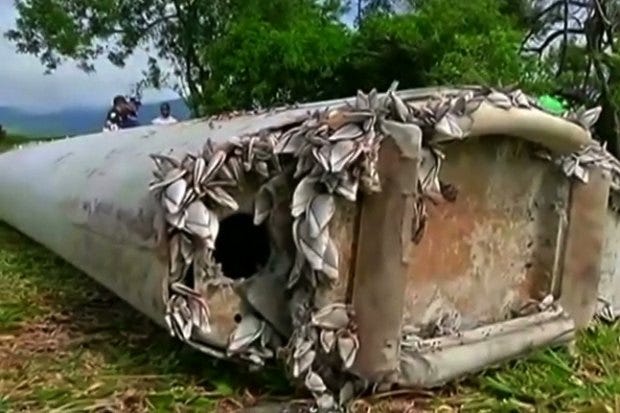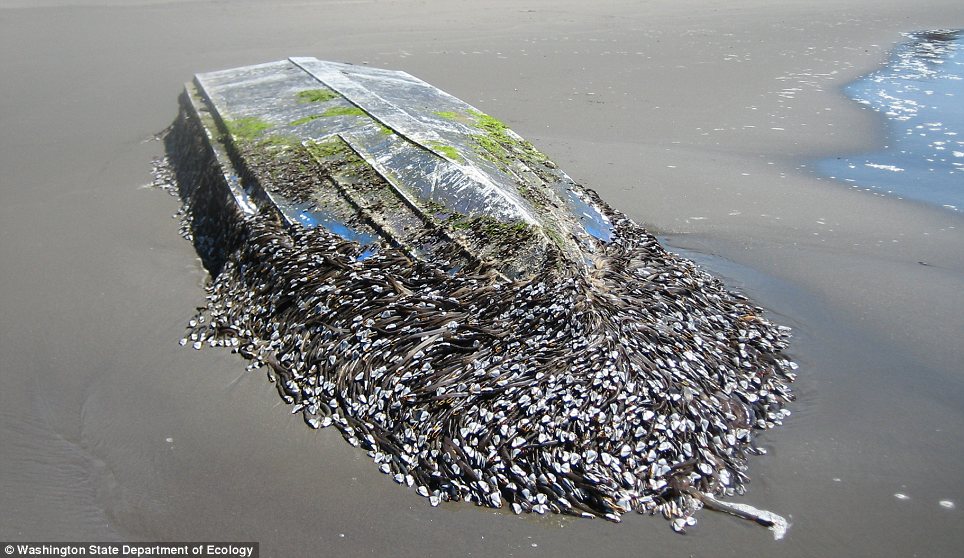To watch Deep Dive: MH370 on YouTube, click the image above. To listen to the audio version on Apple Music, Spotify, or Amazon Music, click here.
For a concise, easy-to-read overview of the material in this podcast I recommend my 2019 book The Taking of MH370, available on Amazon.
At 8.30am on July 29, 2015, on the northeastern shore of Réunion Island, a cleanup crew was working its way along a stretch of pebbly beach when a worker named Johnny Begue spotted an unfamiliar-looking object at the edge of the surf. Roughly rectangular and about six feet long, it somewhat resembled a stubby airplane wing encrusted with marine life.
Soon gendarmes were on the scene, along with local news photographers. The officers put the piece into the back of a Land Rover. Within days it had been packed up, loaded onto an airplane, and flown to France.
The piece was quickly identified as a flaperon, a part of the wing’s trailing edge. The flaperon’s function combines those of a flap, which droop down to allow a plane to fly more slowly on descent to landing, with those of an aileron, which are raised or lowered to cause a plane to turn.
Specifically, this flaperon was identified as coming from the right wing of a Boeing 777. Since the only 777 ever lost at sea was MH370, investigators now had physical evidence to back up what the math had been telling them: the plane had gone into the southern Indian Ocean.
This seemed to be case closed. I wrote a follow-up piece for New York magazine:
“Back in February, I explained in New York how sophisticated hijackers might have infiltrated the plane’s electronic bay in order to spoof the satellite signals and take the plane north to Kazakhstan. MH370 wreckage on the shores of Réunion makes such explanations unnecessary.”
But some people raised questions about the authenticity of the piece. There had been all sorts of conspiracy theories swirling for over a year, and people were skeptical about everything. It was pointed out that the number plate that should have been on the outside of the flaperon was missing. And there were discrepancies between maintenance records kept by Malaysian airlines, which didn’t quite match the flaperon discovered. But that could simply be down to bad record-keeping by Malaysian airlines.
France could have turned the flaperon it over to the Malaysians, but instead decided to keep it and launch their own investigation. It was delivered into the care of the Direction Générale de l’Armement (DGA), France’s weapons development and procurement agency.
At a laboratory in Toulouse, investigators rooted around inside the flaperon with an endoscopic probe and found serial numbers that matched records kept by the manufacturer in Spain. Now there was no doubt that the first piece of MH370 had been found.
Now it seemed to be settled that the flaperon really did come from MH370. But could it help investigators find the missing plane? There were several ways it might help. One was through a process called reverse drift modelling, which investigators could use to estimate where the piece had drifted from. We’ll talk more about this in a future episode. Another is by studying the organisms found growing on the flaperon’s surface.
Using Google and Bing image search, I tracked down photographs of the flaperon taken at every angle by journalists who were on hand immediately after the piece was discovered. I saw barnacles growing on every surface.

I reached out to marine biologists who study these animals and learned that the specimens, commonly known as goose barnacles, belonged to a species called Lepas anatifera. These barnacles live exclusively on debris floating in the open ocean.
Like other barnacles, their larvae spend the early part of their life swimming freely and then, in a final larval phase called the cyprid stage, search out a floating object on which to settle. Once they find a suitable object, says marine biologist Hank Carson, “cyprids in general do do a fair bit of exploration for that cementation spot” upon it, and with good reason: they’ll spend the rest of their life there. Among the criteria they assess is how crowded a spot is, what the underlying substrate consists of, and how deep it is. Once satisfied, they glue their heads in place.
Lepas only grow underwater, so the fact that the flaperon was covered in barnacles on all sides implied that none of it was sticking up into the air. Yet I knew that to be an impossibility: if something is floating totally submerged, it will eventually sink to the bottom.
To address this seeming paradox, DGA researchers put the flaperon in a water tank. They found that it floated half out of the water, like this:

This was puzzling. How could these underwater creatures have grown on portions of the part that stuck up out of the water? Eventually I was able to obtain a copy of a confidential report that had been prepared for French investigators by a man named Pierre Daniel of the organization Météo France. In the report Daniel points out that that the degree to which a floating object sticks up into the air is crucial for modeling how it will drift, because the more it protrudes, the more it will be affected by winds:
The buoyancy of the piece such as it was discovered is rather important. The studies by the DGA Hydrodynamic Engineering show that under the action of a constant wind, following the initial situation, the piece seems able to drift in two positions: with the trailing edge or the leading edge facing the wind. The drift angle has the value of 18 degrees or 32 degrees toward the left, with the speed of the drift equal to 3.29% or 2.76% of the speed of the wind, respectively.
The presence of barnacles of the genus Lepas on the two sides of the flaperon suggest a different waterline, with the piece being totally submerged. In this case we derive a speed equaly to zero percent of the wind. The object floats solely with the surface current.
IN OTHER WORDS, DANIEL COULDN’T TELL HOW TO MODEL HOW THE FLAPERON COULD DRIFT, BECAUSE AN EXAMINATION OF THE OBJECT SUGGESTED CONTRADICTORY IDEAS ABOUT HOW IT CROSSED THE OCEAN. ONCE AGAIN, A PIECE OF MH370 EVIDENCE WAS GENERATING MORE QUESTIONS THAN ANSWERS! UNABLE TO TELL WHICH INTERPRETATION WAS CORRECT, Daniel pressed on, conducting his analysis along two parallel tracks, one which assumed that the piece floated high, and the other in which it floated submerged. After running hundreds of thousands of simulated drift trials, Daniel concluded that if the piece floated high and was pushed by the wind, it could have originated near the underwater search area.
But if it floated as its Lepas population suggests, that is to say submerged, then it couldn’t have started anywhere near the current seabed search area. Its most likely point of origin would have been close to the equator, near Indonesia.
Curiosity piqued, I decided to come at the topic a different way, by trying to figure out how old the barnacles were. Given a healthful environment, Lepas are notoriously fast-growing. The animals evolved to live on floating organic debris which after a time will break apart and sink, so time is of the essence. Whereas a species of goose barnacle that lives attached to a rock might take five years to reach sexual maturity, Lepas can do it in mere weeks.
As a result Lepas-settled flotsam can become extremely crowded in short order, with individuals crammed onto every available surface right up to the uppermost limit of what they can survive. Pictured below is a Japanese skiff that was swept to sea after the Tohoku tsunami in March, 2011, and made landfall on a beach in Washington state in June of the following year, meaning that it floated capsized for about 15 months—about the same amount of time that had elapsed between MH370’s disappearance and the beaching of the flaperon. As you can see, there’s a big difference in how much barnacle growth has occurred.

When I asked barnacle experts how old the flaperon’s barnacles seemed to be, they all said that the Lepas looked to be much less than 15 months old. Japanese researcher Yoichi Yusa, who had studied the growth rate of a related Lepas species, Lepas anserifera, told me via email that: “I would guess that they had been there for a short time (between 2 weeks and a few months).” Cynthia Venn’s, a professor of oceanography and geology at Bloomsburg University in Pennsylvania who has studied Lepas extensively, estimated that their age was “less than six months.”
I began to wonder: is the flaperon really telling us that the plane went into the southern Indian Ocean? Or perhaps suggested that someone might have wanted to make it seem that way by planting debris?
Dear Jeff,
There is another option; The aircraft or a big part of it survived the impact and was floating around in the Indian Ocean for weeks may be months before it broke up by the weather and disapared in a different position. From there the ailron broke off and sailed to Reunion.
I have myself sailed across the Indian ocean with a big ship, a 50.000 tdw bulk carrier fram Cape the Good Hope in Africa to the Sunda straight Indonesia 21 days at sea without seeing anything but an empty horizon.
From our commanding bridge 23 meters above the sea level we saw nothing except sky and water in 21 days!
The southern Indian Ocean is allmost emty and very very big! It is no reason to believe that anyone would happen to detect an aircraft wreck floating low in the water in that area if not directly serched for.
If we antisipate that the aircraft was flying untill empty of fuel it was a huge capasity of empty boyance in the wings to keep it on the surface for some time if it came down in a gliding sloop without a destructive crash.
In this case any ide is as good as another.
BRGDS
Thom O.Olsen, Norway
@Thom, Yes, it seems like the only way to explain the appearance of the flaperon is that it was somehow attached to a larger piece of debris–presumably a section of the wing–that held it underwater from moment of impact until just before it was discovered, as these animals appeared to be quite fresh. That would raise the question of why the larger wing piece wasn’t also discovered, since it would also be quite buoyant. So many questions…
Jeff
With the time between when the plane allegedly crashed in the Southern Indian Ocean and the when the parts were found doesn’t add up. 16 months between? I think they’re looking in the wrong location for MH370. I think it was hijacked to Somalia and the parts deposited into the ocean. Parts wouldn’t wash up between the coast of Africa and Madagascar if it was in the Southern Indian Ocean.
Hey Jeff
Check out the podcast Ministry of Secrets which unpacks the mystery of the disappearance of Lionel Crabb whose body turned up after being partially submerged -it has similarities to your suggestions in Episode 18…
@Sue, Interesting, thanks!
@Jason, From certain parts of the search area debris probably would have washed up between the coast of Madagascar eventually, but there are definitely multiple problems with the debris.